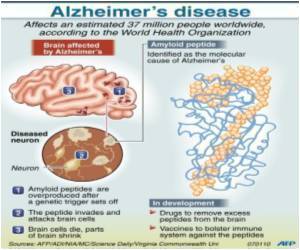In a welcome breakthrough, scientists have successfully restored learning and memory in an Alzheimer's disease mouse model by increasing a protein called CBP.

The finding provides a novel therapeutic target for development of Alzheimer's medications, Oddo said.
In patients with Alzheimer's disease, accumulation of a protein called amyloid-B (AB) blocks memory formation by destroying synapses, the sites where neurons share information. Autopsies of the brains of some Alzheimer's patients also reveal tangles caused by a protein called tau.
Enhancing CBP does not alter the AB or tau physiology but operates on a different recovery mechanism: It restores activity of a protein called CREB and increases levels of another protein called brain-derived neurotrophic factor (BDNF).
The research team engineered a harmless virus to deliver CBP to the hippocampus in the temporal lobe. The hippocampus is the brain's key structure for learning and memory.
At 6 months of age, when the CBP delivery took place, the specially bred mice were at the onset of Alzheimer's-like deficits. Learning and memory were evaluated in a water maze that required mice to remember the location of an exit platform.
Advertisement
Efficiency in escaping the maze served as signs of learning and memory. In the Alzheimer's mouse model, performance of the Alzheimer's mice treated with enhanced CBP was identical to the healthy mice, whereas the placebo-treated Alzheimer's mice lagged far behind.
Advertisement
Source-ANI














